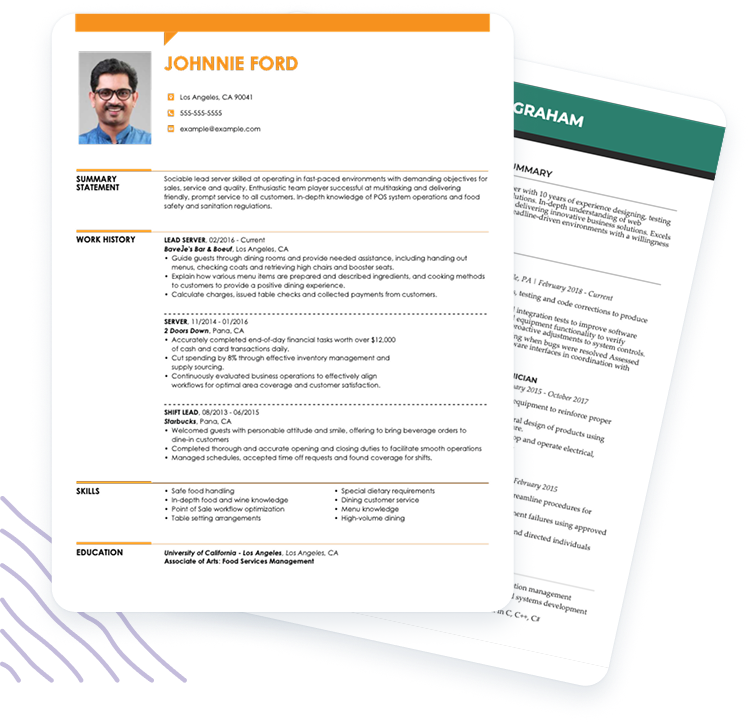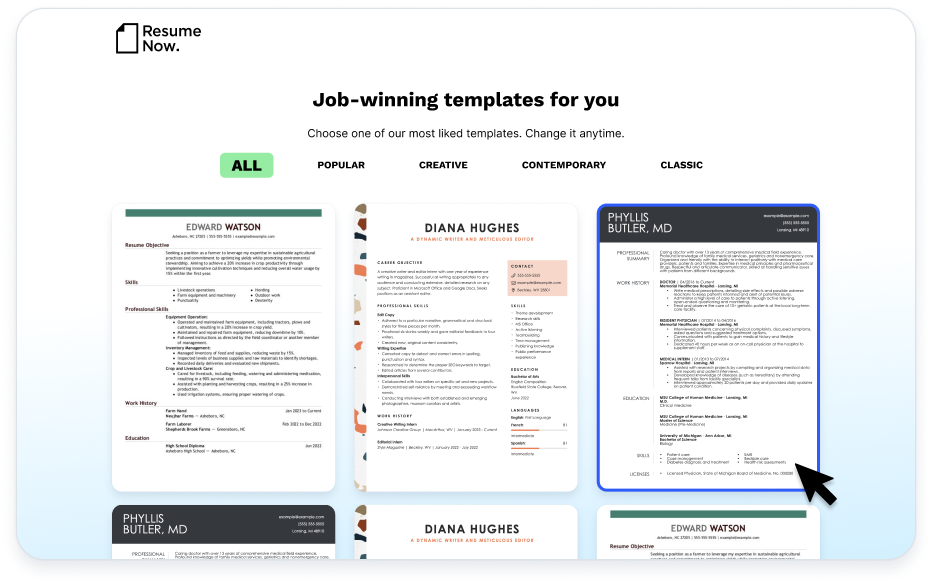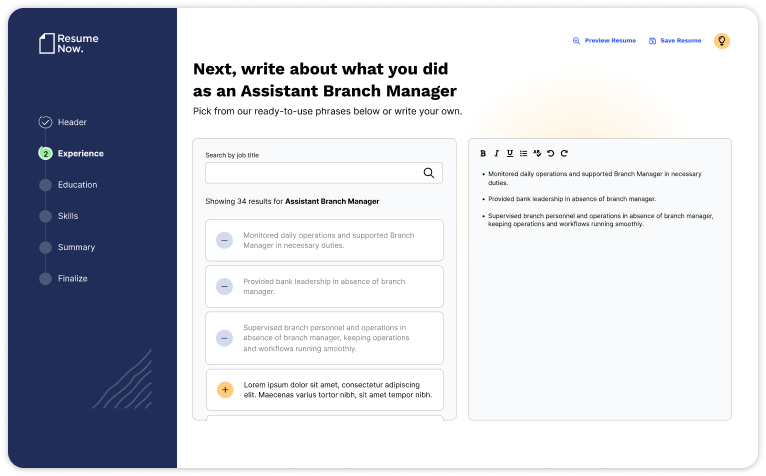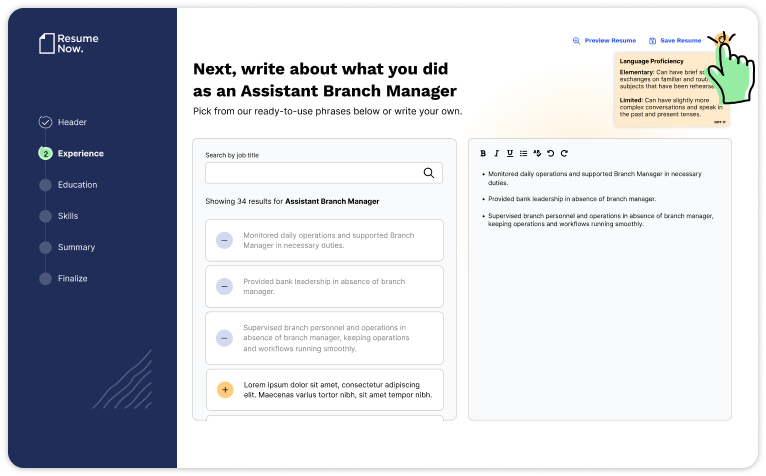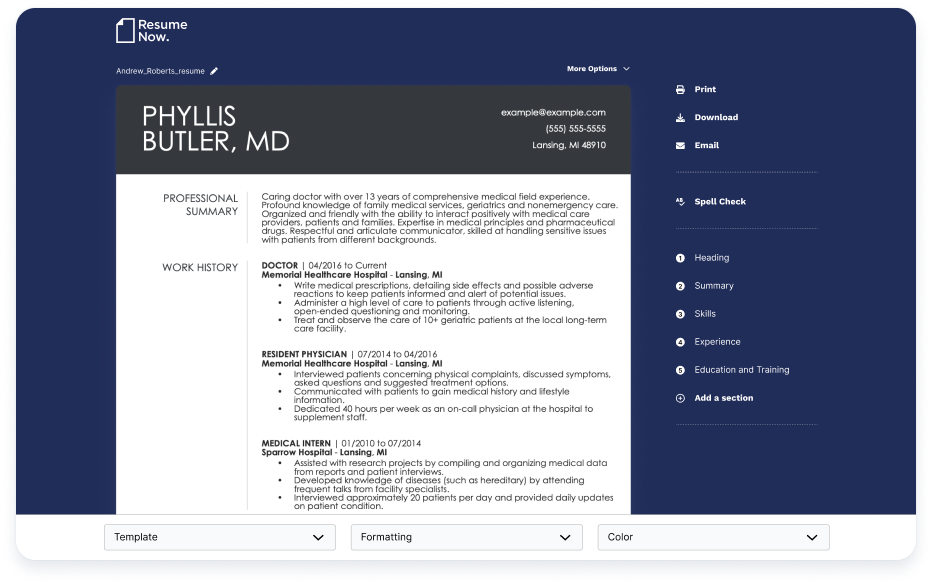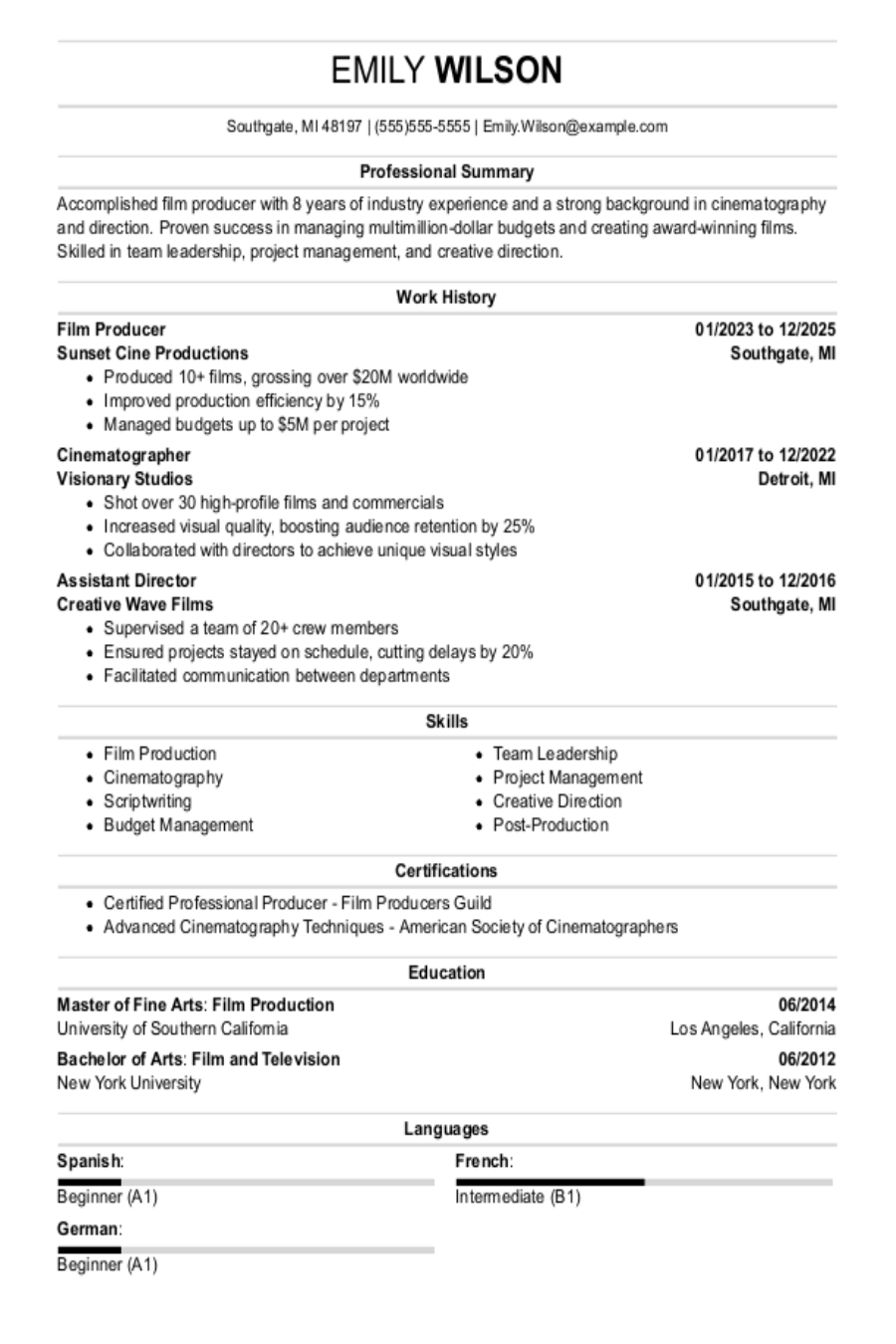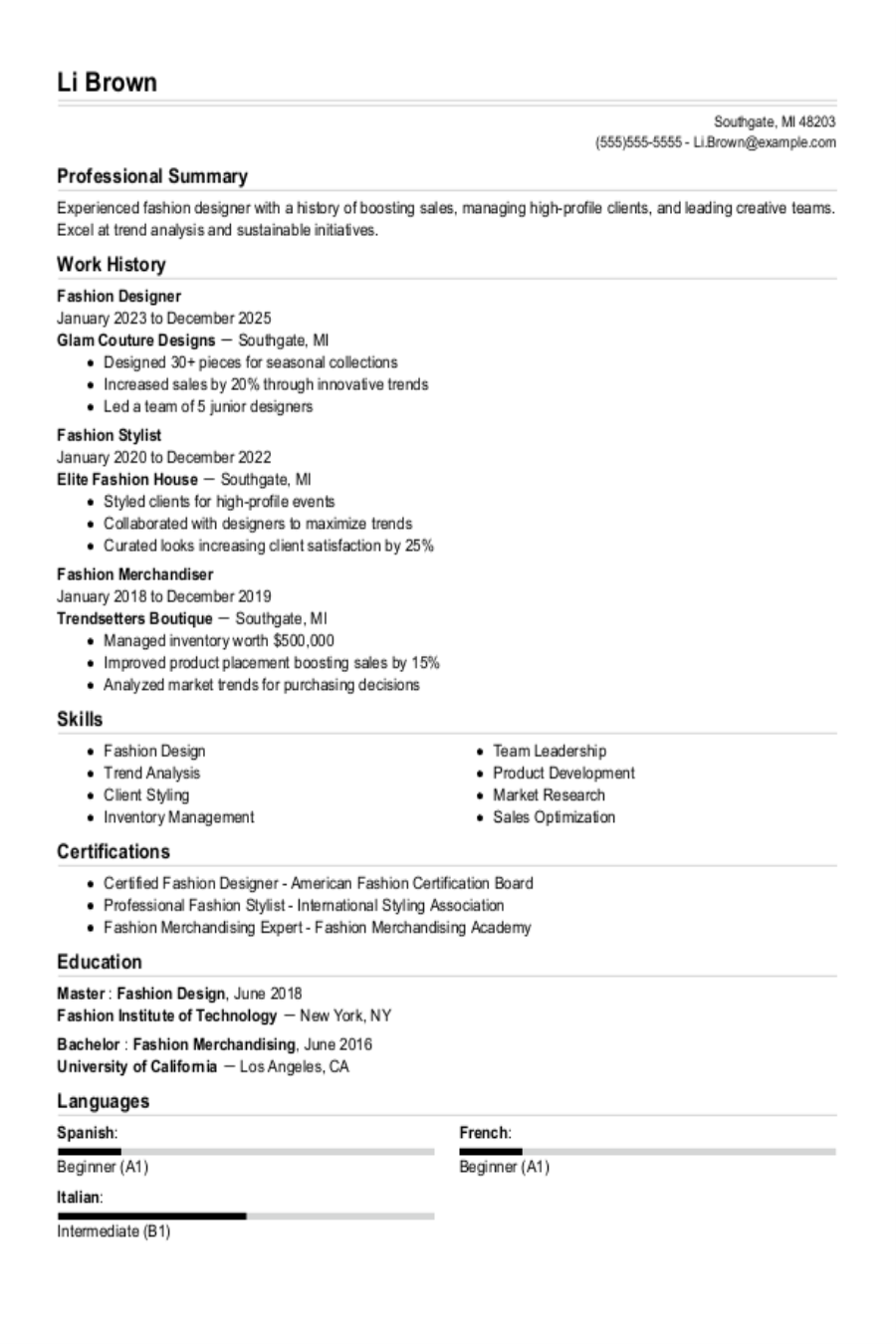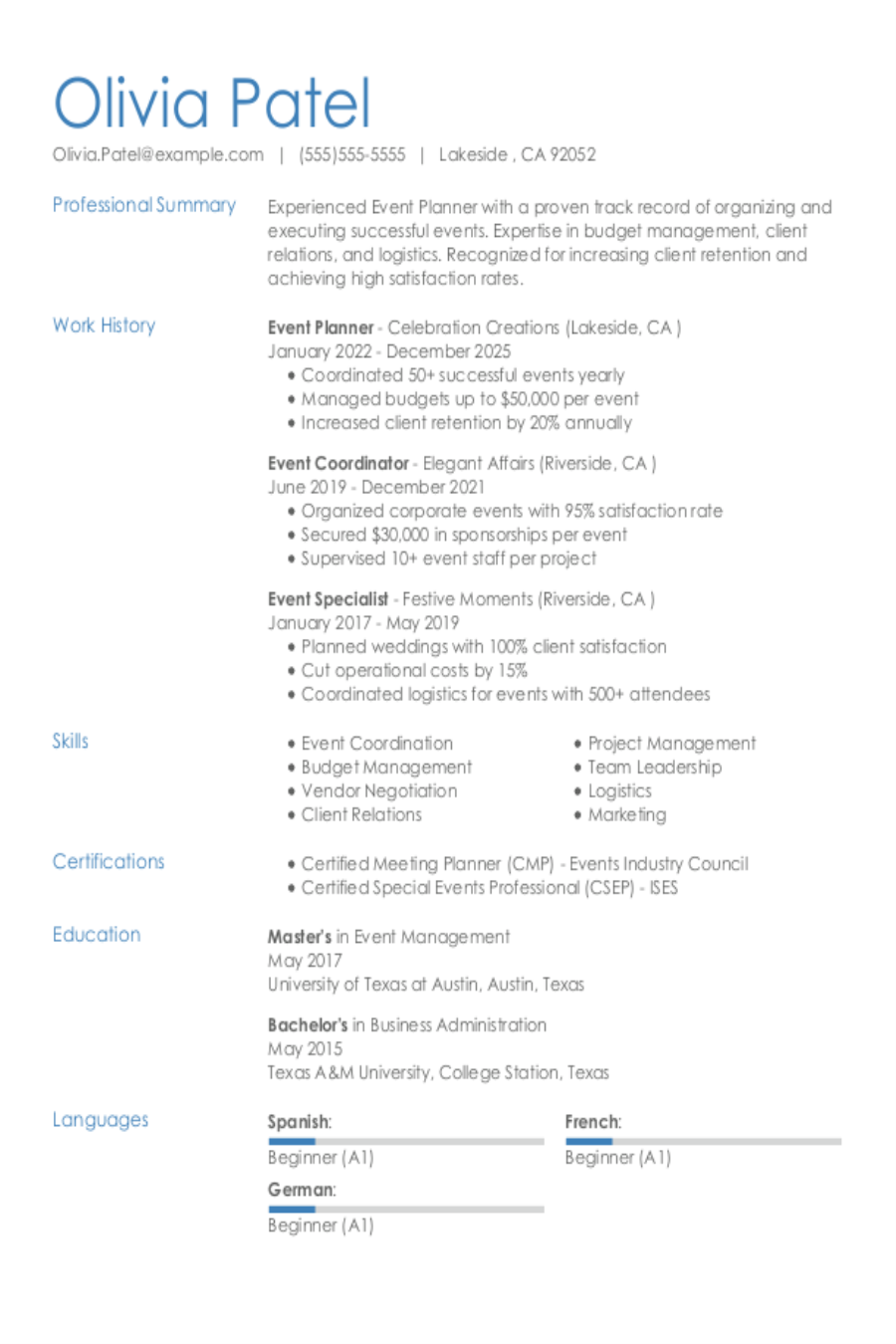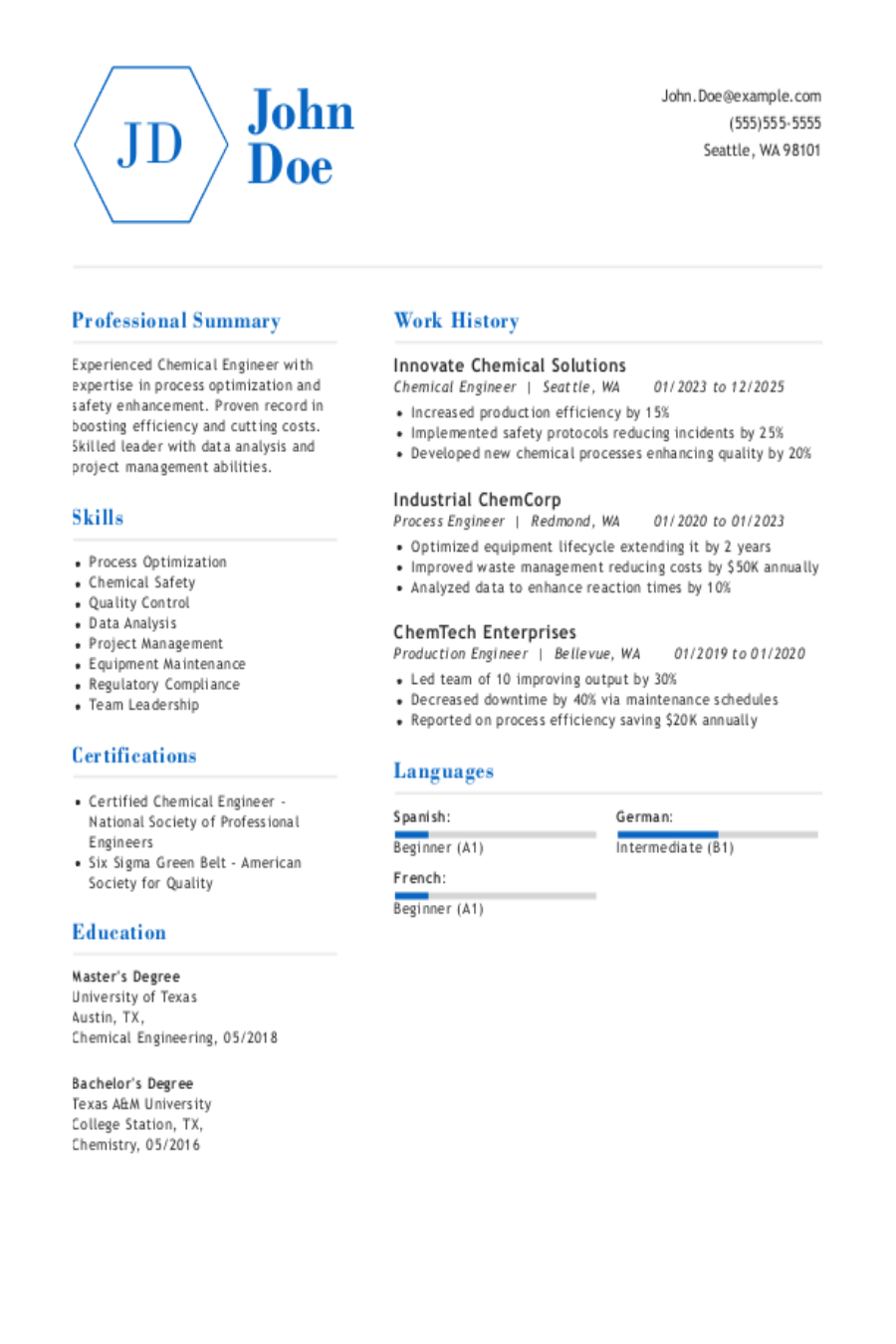The chronological resume format prominently displays your employment history, with your most recent work experience listed first. Featuring work history makes it easy for hiring managers to quickly scan your resume to see whether your skills and experience align with the requirements of the open role.
Despite its popularity, the chronological format—sometimes referred to as the reverse-chronological resume or standard resume format—isn’t the only valid choice for a resume. Our guide will help you decide whether it’s the right option for you. We’ll cover:
- What is a chronological resume?
- Who should use the chronological resume format?
- A selection of chronological resume templates and examples
- Tips for how to write a chronological resume
- More resources to help you make a strong resume
- Frequently asked questions about the chronological resume format
Ready to get to work on your chronological resume? Resume Now’s AI Resume Builder provides AI writing assistance, unique expertly-designed chronological templates, and examples to help you create a resume that impresses employers.
What Is a Chronological Resume?
A chronological resume details your work history by starting with your most recent job position and working backward from there. Each role lists your responsibilities and achievements, making the chronological resume the ideal choice for those with significant, relevant work experience.
A chronological resume is one of the three types of resume formats. In fact, hiring managers in the U.S. prefer the chronological resume format because it is easy to scan and helps them gauge if a candidate is qualified for the role.
Unlike the combination resume format or the functional resume format, the chronological format, by definition, places the most emphasis on an applicant’s work history. In short, experienced applicants should use a chronological resume versus a functional resume, which is more appropriate for inexperienced applicants.
Structure of a chronological resume
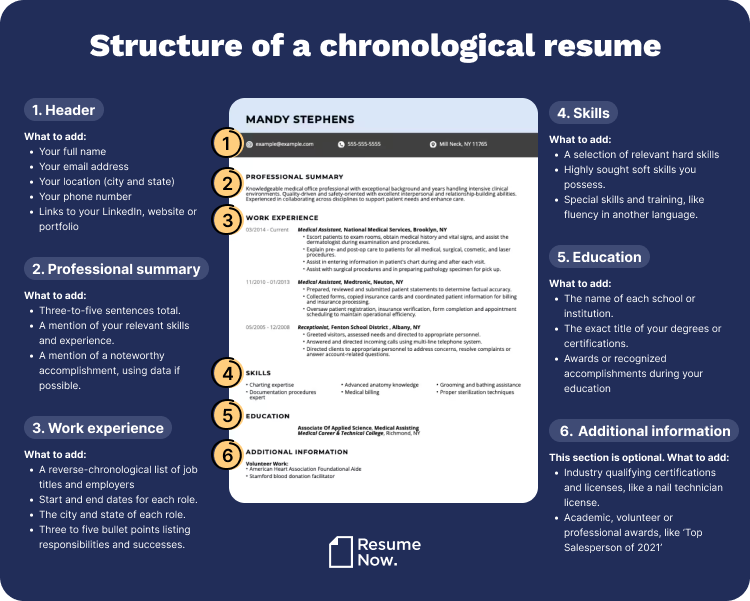

Who Should Use the Chronological Resume Format?
You should use the chronological resume format to apply for a job if:
- You have at least five years of relevant work experience
- You have a steady employment track record
- Your skills match the job description closely
- You can show steady job advancement
Pros and cons of using a chronological resume
Pros
- This format is compatible with applicant tracking system (ATS) software, allowing it to scan your resume quickly for keywords.
- It prioritizes your on-the-job experience. Hiring managers can easily see your past employers and job titles at a glance, which is advantageous if you worked for well-known or prestigious companies.
- It devotes a lot of space to your work history, giving you room to list quantifiable achievements in each role.
- This format lets recruiters see how you’ve moved up the career ladder.
Cons
- Any gaps in your employment history will be made evident with this format.
- Skills, education, or training take a backseat to work experience.
- “Job-hopping”—making frequent job changes—stands out on a chronological resume.
- Freelance, contract, and other short-term jobs can be tricky to explain in a chronological resume format.
- This format doesn’t work well for applicants with little to no work experience.
For other examples of resume formats, see our combination and functional format pages.
Chronological Resume Template and Examples
Free downloadable chronological resume template
As you learn how to format your resume, using one of our premium or free resume templates can help. Our templates ensure that your resume is properly formatted and organized. We offer modern, professional, creative, and simple templates to suit every job seeker and industry.
Check out our full selection of resume templates, or download the template below for free and insert your resume information.
Chronological resume example
Whether you’re applying for a job in nursing, customer service, engineering, or IT—or any other field—studying chronological resume samples can be beneficial.
Find a sample chronological resume example for the job title you seek and learn how to write a resume that will get you noticed.
How to Write a Chronological Resume & Tips for Every Section
Tips for writing the resume header
- Use your full name and not a nickname.
- List a professional email address.
- Only add your city and state, not your complete mailing address.
Tips for writing the professional summary
- Keep your professional summary short—three to five sentences are all you need.
- Find relevant skills and experience in the job ad and list them here.
- Use data to highlight a professional accomplishment, such as “Increased monthly revenue by 12%.”
Tips for writing the work experience section
- Write your work experience in reverse-chronological order, listing the most recent job first. Include only relevant jobs from the past decade.
- Use bullet points to highlight your job responsibilities for each role, including more detail for recent roles and less for older ones.
- Incorporate data and metrics whenever possible to show the impact of your work.
Tips for writing the education section
- Double-check the exact title of your degrees and certifications to ensure they are listed accurately.
- Be sure to highlight any academic awards you’ve received.
- Don’t list your dates of graduation; doing so can introduce age bias into the hiring process.
More Resources
Need more support writing your resume? Resume Now’s expansive library of resume samples features resume examples from professionals in almost every field. Examine a sample resume from your role and industry to help jumpstart your writing process.
Need to write a cover letter to show employers your enthusiasm for the role and complement your resume? Try Resume Now’s AI Cover Letter Generator for quick and easy writing assistance, AI content suggestions, and professional and stylish cover letter templates designed to complement our library of resume templates.
FAQ
List your work experience on your resume in reverse-chronological order, starting with your most recent position and working backward in time. Generally, you should only include jobs from the past 10 years. Follow the same arrangement for your education section, with your latest, most advanced degree (or coursework, if you haven’t completed your studies yet) presented first.
Yes. In a chronological resume, your work history is always presented in reverse-chronological order. However, if you have gaps in your work experience or lack extensive experience, you may want to consider a functional resume, which focuses on your abilities and skills.
In the chronological format, work experience will appear first. This allows you to show hiring managers that you have the necessary experience to excel at a new job.
Like your work history section, the education section should start with your most recent degree or accomplishment. You should include information about your degrees, relevant coursework, notable achievements, and certificate programs.
There are three main ways to make a chronological resume stand out. They are:
- Mirror the job description. You can stand out by highlighting any skills from the job ad that you possess. If you have specific certifications, licenses, or other training that are listed in the job ad, be sure to mention them.
- Focus on your achievements. Employers don’t want to read a long list of job responsibilities. Hiring managers want to know the impact you have made in past positions to see what you’ll bring to the table. To drive it home, use data and metrics whenever possible. For example, instead of writing that you “Welcomed customers and answered questions,” you should write, “Increased customer satisfaction by 40% through high-quality customer service.”
- Write a compelling summary statement. Many job seekers use generic summary statements such as, “Good communicator with 10 years of sales experience.” If you want to stand out, make your summary enticing. Write a compelling statement, such as “Proven success in revitalizing underperforming sales numbers through scalable marketing strategies that have driven a 32% increase in leads,” which is sure to get attention.
It depends. Most experts agree it’s best to stay with a company for at least two years because it shows a level of commitment and a thoughtful understanding of your own career path. But if one or two of your jobs lasted a year or less, it is OK to add them. Just be prepared to confidently and clearly explain why they were short-term stints during your interview.
You can also address any such concerns in your cover letter. However, if you’ve had several short-term jobs throughout your career or within one year, then a functional resume format is a better option for you.
Absolutely. You can make the chronological format work for you if your career change entails applying for the next step up from your current role, and you have a track record of stable work experience and a clear path of advancement in the industry.
For example, if you’ve been a construction worker for five years and want to apply for a project manager job, it’s acceptable to use the chronological format. However, if you are a nanny and want to apply for an administrative assistant position, you should use the functional format.

